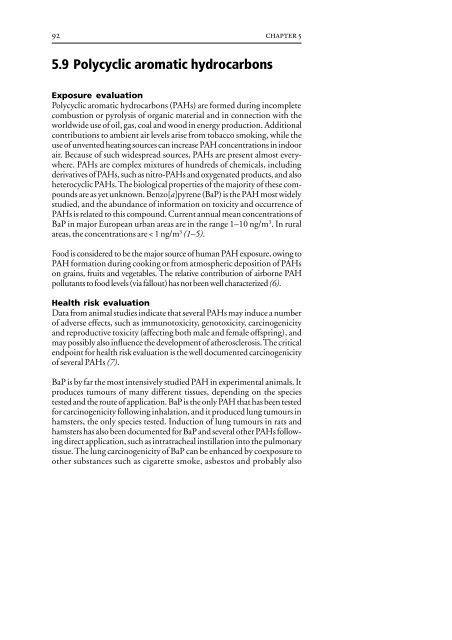Air Quality Guidelines - World Health Organization Regional Office ...
Air Quality Guidelines - World Health Organization Regional Office ...
Air Quality Guidelines - World Health Organization Regional Office ...
You also want an ePaper? Increase the reach of your titles
YUMPU automatically turns print PDFs into web optimized ePapers that Google loves.
92 chapter 5<br />
5.9 Polycyclic aromatic hydrocarbons<br />
Exposure evaluation<br />
Polycyclic aromatic hydrocarbons (PAHs) are formed during incomplete<br />
combustion or pyrolysis of organic material and in connection with the<br />
worldwide use of oil, gas, coal and wood in energy production. Additional<br />
contributions to ambient air levels arise from tobacco smoking, while the<br />
use of unvented heating sources can increase PAH concentrations in indoor<br />
air. Because of such widespread sources, PAHs are present almost everywhere.<br />
PAHs are complex mixtures of hundreds of chemicals, including<br />
derivatives of PAHs, such as nitro-PAHs and oxygenated products, and also<br />
heterocyclic PAHs. The biological properties of the majority of these compounds<br />
are as yet unknown. Benzo[a]pyrene (BaP) is the PAH most widely<br />
studied, and the abundance of information on toxicity and occurrence of<br />
PAHs is related to this compound. Current annual mean concentrations of<br />
BaP in major European urban areas are in the range 1–10 ng/m 3 . In rural<br />
areas, the concentrations are < 1 ng/m 3 (1–5).<br />
Food is considered to be the major source of human PAH exposure, owing to<br />
PAH formation during cooking or from atmospheric deposition of PAHs<br />
on grains, fruits and vegetables. The relative contribution of airborne PAH<br />
pollutants to food levels (via fallout) has not been well characterized (6).<br />
<strong>Health</strong> risk evaluation<br />
Data from animal studies indicate that several PAHs may induce a number<br />
of adverse effects, such as immunotoxicity, genotoxicity, carcinogenicity<br />
and reproductive toxicity (affecting both male and female offspring), and<br />
may possibly also influence the development of atherosclerosis. The critical<br />
endpoint for health risk evaluation is the well documented carcinogenicity<br />
of several PAHs (7).<br />
BaP is by far the most intensively studied PAH in experimental animals. It<br />
produces tumours of many different tissues, depending on the species<br />
tested and the route of application. BaP is the only PAH that has been tested<br />
for carcinogenicity following inhalation, and it produced lung tumours in<br />
hamsters, the only species tested. Induction of lung tumours in rats and<br />
hamsters has also been documented for BaP and several other PAHs following<br />
direct application, such as intratracheal instillation into the pulmonary<br />
tissue. The lung carcinogenicity of BaP can be enhanced by coexposure to<br />
other substances such as cigarette smoke, asbestos and probably also

















